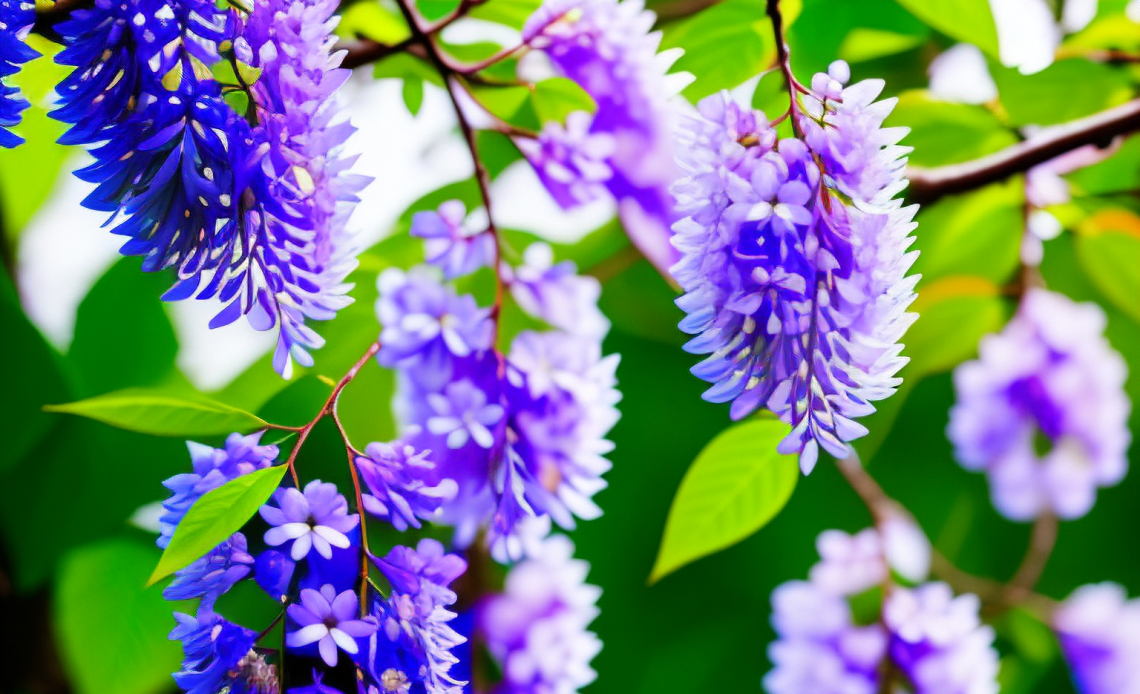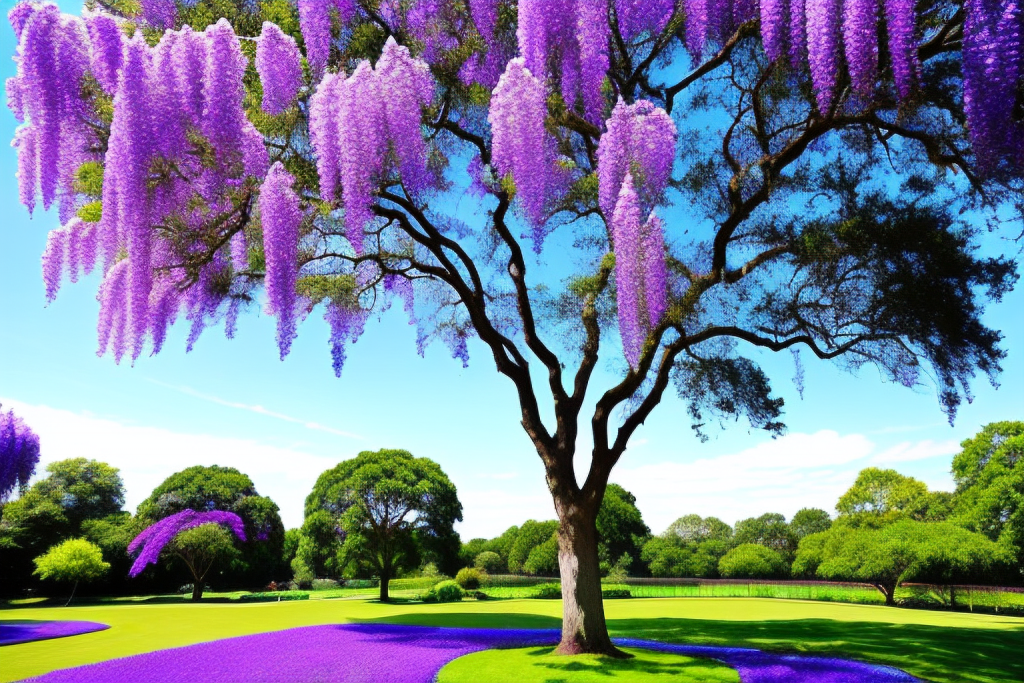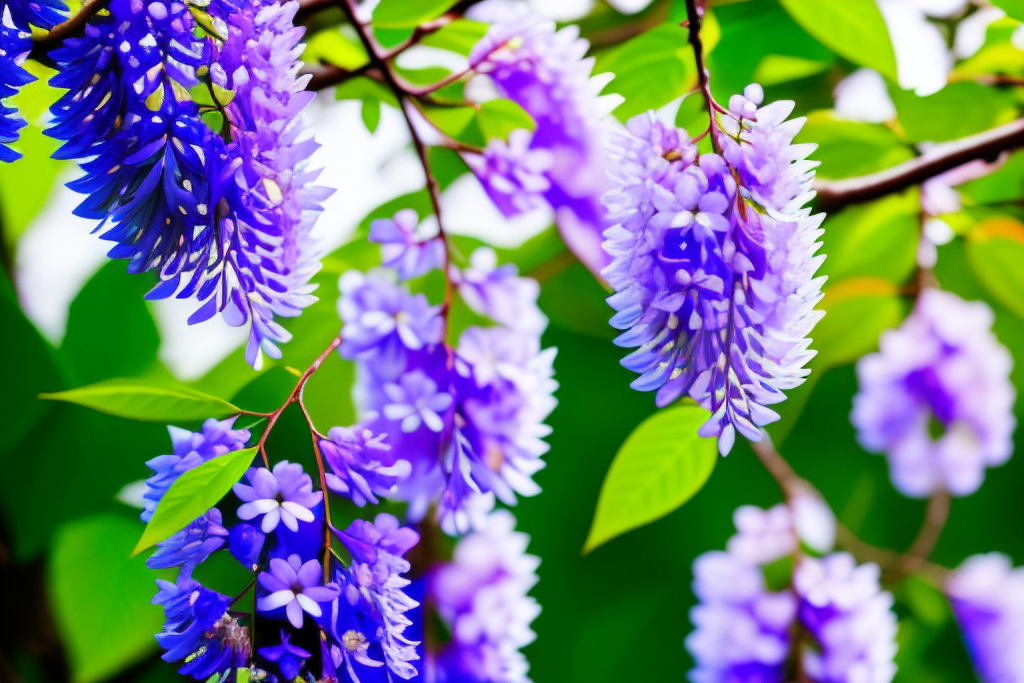
Discover the beauty and wonder of the Blue Chinese Wisteria Tree, a stunning addition to any backyard. The Blue Chinese Wisteria Tree is a true masterpiece of nature that can transform your outdoor space into a breathtaking oasis. With its vibrant blue color and cascading blooms, this tree is sure to grab attention and create a sense of awe.
One of the unique characteristics of the Blue Chinese Wisteria Tree is its twisting vines, which add an element of elegance and charm. These vines can be trained and pruned to create stunning visual displays, making the tree a standout feature in your landscape design. Whether you choose to grow it on a pergola, arbor, trellis, or fence, the Blue Chinese Wisteria Tree will surely become the focal point of your backyard.
Caring for the Blue Chinese Wisteria Tree is essential to ensure its health and longevity. Proper planting and watering techniques are crucial for promoting healthy growth and abundant blooms. It is important to provide the tree with the right amount of moisture and ensure it is planted in ideal soil conditions. Regular pruning and pest control measures are also necessary to maintain the tree’s beauty and prevent any potential diseases.
Incorporating the Blue Chinese Wisteria Tree into your landscape design can be a creative and inspiring process. You can use its unique characteristics and vibrant color to create a stunning outdoor space. Whether you choose to create a shaded seating area under a pergola adorned with the tree’s cascading blooms or use it to enhance the beauty of a fence or trellis, the Blue Chinese Wisteria Tree will add a touch of elegance and natural beauty to your backyard.
In conclusion, the Blue Chinese Wisteria Tree is a nature’s masterpiece that can bring beauty and wonder to your backyard. By understanding its unique characteristics, caring for it properly, and incorporating it into your landscape design, you can create a stunning outdoor space that will be the envy of all. So, why wait? Bring the beauty of the Blue Chinese Wisteria Tree into your backyard and enjoy its splendor for years to come.
Characteristics of the Blue Chinese Wisteria Tree

The Blue Chinese Wisteria Tree is known for its unique and captivating characteristics that make it a true standout in any garden. One of its most striking features is its cascading blooms, which create a breathtaking display of color and beauty. These blooms hang down in long, graceful clusters, creating a stunning visual effect that is sure to capture the attention of anyone who sees it.
Another standout characteristic of the Blue Chinese Wisteria Tree is its vibrant blue color. The flowers of this tree are a deep, rich blue hue that is truly eye-catching. This vibrant color adds a touch of elegance and sophistication to any landscape, making it a popular choice for those looking to create a visually stunning garden.
In addition to its cascading blooms and vibrant blue color, the Blue Chinese Wisteria Tree is also known for its twisting vines. These vines can grow quite long and are often used to create beautiful archways, trellises, and pergolas. The twisting vines add a sense of movement and drama to the tree, further enhancing its allure and making it a true masterpiece of nature.
Overall, the distinct features of the Blue Chinese Wisteria Tree contribute to its allure and make it a standout tree in any garden. From its cascading blooms to its vibrant blue color and twisting vines, this tree is sure to captivate and impress all who encounter it.
Caring for the Blue Chinese Wisteria Tree
Caring for the Blue Chinese Wisteria Tree is crucial to ensure its health and longevity in your backyard. By following essential care tips and techniques, you can maintain this nature’s masterpiece and enjoy its beauty for years to come.
Proper planting and watering are the first steps in caring for your Blue Chinese Wisteria Tree. Choose a location that receives full sun and has well-drained soil. Dig a hole that is twice as wide and deep as the root ball, and gently place the tree in the hole. Fill the hole with soil, firming it gently around the base of the tree. Water the tree thoroughly after planting, and continue to water it regularly, especially during dry periods.
Pruning is another important aspect of caring for the Blue Chinese Wisteria Tree. Prune the tree in late winter or early spring before new growth begins. Remove any dead, damaged, or diseased branches, as well as any crossing or rubbing branches. Prune to maintain the desired shape and size of the tree, and train the branches and vines to create stunning visual displays.
Pest control and disease prevention are also essential for the health of your Blue Chinese Wisteria Tree. Keep an eye out for common pests such as aphids and caterpillars, and use organic or chemical methods to control them if necessary. Regularly inspect the tree for signs of diseases like powdery mildew or root rot, and take appropriate measures to prevent and treat them.
By following these care tips and techniques, you can ensure the health and longevity of your Blue Chinese Wisteria Tree, allowing it to thrive and beautify your backyard.
Planting and Watering

When it comes to planting and watering your Blue Chinese Wisteria Tree, following expert advice is key to promoting healthy growth and abundant blooms. Start by selecting the ideal location in your backyard that receives full sun or partial shade. The tree thrives in well-drained soil, so make sure the soil is loose and fertile.
Before planting, dig a hole that is twice as wide and deep as the tree’s root ball. Gently remove the tree from its container and place it in the hole, making sure that the top of the root ball is level with the ground. Backfill the hole with soil, firming it gently around the roots to eliminate air pockets.
Watering is crucial for the Blue Chinese Wisteria Tree’s health and vitality. Provide the right amount of moisture by watering deeply once a week during dry spells. The tree prefers evenly moist soil, but be careful not to overwater, as this can lead to root rot. Mulching around the base of the tree helps retain moisture and suppresses weed growth.
By understanding the ideal soil conditions, watering frequency, and techniques for providing the right amount of moisture, you can ensure that your Blue Chinese Wisteria Tree thrives and produces an abundance of beautiful blooms.
Pruning and Training
Pruning and training the Blue Chinese Wisteria Tree is an art that allows you to shape and control the growth of this magnificent tree. By understanding when and how to prune, as well as employing effective training techniques, you can achieve the desired shapes and sizes that will enhance the beauty of your backyard.
When it comes to pruning the Blue Chinese Wisteria Tree, timing is crucial. The best time to prune is during the dormant season, which is typically in late winter or early spring. During this time, the tree is less likely to experience excessive bleeding or sap loss. It’s important to remove any dead or damaged branches, as well as any suckers that may be growing from the base of the tree.
When pruning, make sure to use clean and sharp pruning shears to make clean cuts. Avoid leaving stubs or jagged edges, as this can lead to disease or pest infestation. Additionally, consider the desired shape and size of the tree and prune accordingly. You can train the branches and vines to grow in specific directions by gently bending and tying them to a support structure, such as a trellis or pergola.
By pruning and training the Blue Chinese Wisteria Tree, you can create stunning visual displays in your backyard. Imagine a pergola covered in cascading blooms or a trellis adorned with vibrant blue flowers. With proper pruning and training techniques, you can turn your backyard into a breathtaking oasis that showcases the beauty of this nature’s masterpiece.
Pest Control and Disease Prevention
Pest control and disease prevention are crucial for maintaining the health and beauty of your Blue Chinese Wisteria Tree. By being aware of common pests and diseases that can affect this stunning tree, you can take proactive measures to prevent and control them.
Some common pests that may target your Blue Chinese Wisteria Tree include aphids, scale insects, and caterpillars. These pests can cause damage to the leaves, flowers, and overall health of the tree. To prevent infestations, regularly inspect your tree for signs of pests and take immediate action if any are found.
There are both organic and chemical methods available for pest control. Organic options include using insecticidal soaps, neem oil, or introducing beneficial insects like ladybugs and lacewings to your garden. These methods are environmentally friendly and safe for the tree.
If organic methods are not effective, chemical insecticides can be used as a last resort. However, it is important to carefully follow the instructions and dosage recommended by the manufacturer to avoid harming the tree or the environment.
In addition to pests, diseases can also pose a threat to your Blue Chinese Wisteria Tree. Common diseases include powdery mildew, leaf spot, and root rot. To prevent these diseases, ensure proper air circulation around the tree, avoid overwatering, and promptly remove any infected leaves or branches.
Using fungicides can also help in controlling and preventing diseases. Be sure to choose a fungicide specifically formulated for wisteria trees and follow the instructions for application.
By implementing effective pest control and disease prevention strategies, you can ensure the continued health and beauty of your Blue Chinese Wisteria Tree, allowing it to thrive and bring joy to your backyard for years to come.
Incorporating the Blue Chinese Wisteria Tree into Your Landscape Design

When it comes to incorporating the Blue Chinese Wisteria Tree into your landscape design, the possibilities are endless. This stunning tree can be showcased in various ways to create a breathtaking outdoor space that will leave everyone in awe.
One creative idea is to use pergolas and arbors as a support structure for the Blue Chinese Wisteria Tree. By planting the tree near these structures, you can train its vines to grow and cascade over the pergola or arbor, creating a beautiful canopy of vibrant blue blooms. This not only adds a touch of elegance to your outdoor space but also provides a shady retreat.
Trellises and fences are another great way to incorporate the Blue Chinese Wisteria Tree into your landscape design. By planting the tree near a trellis or fence, you can guide its vines to climb and cover the structure, creating a stunning vertical display of cascading blooms. This not only adds visual interest but also serves as a natural privacy screen.
In addition to pergolas, arbors, trellises, and fences, you can also consider using the Blue Chinese Wisteria Tree as a focal point in your garden. Planting it in a strategic location where it can be admired from different angles will create a striking visual impact. You can surround the tree with other plants and flowers that complement its vibrant blue color, creating a harmonious and captivating garden design.
Remember, the key is to let your imagination run wild and think outside the box. Don’t be afraid to experiment with different ideas and combinations to create a landscape design that truly showcases the beauty of the Blue Chinese Wisteria Tree. With its cascading blooms and vibrant blue color, this nature’s masterpiece is sure to transform your outdoor space into a stunning oasis.
Conclusion
The Blue Chinese Wisteria Tree is a true masterpiece of nature that has the power to transform your backyard into a stunning oasis. Its cascading blooms, vibrant blue color, and twisting vines make it a standout tree in any garden. By understanding the unique characteristics of this tree and providing it with proper care, you can ensure its health and longevity.
Proper planting and watering techniques are essential for the Blue Chinese Wisteria Tree to thrive. It requires well-draining soil and regular watering to promote healthy growth and abundant blooms. Pruning and training the tree’s branches and vines allow you to shape it according to your desired aesthetic, creating stunning visual displays.
However, it’s important to be aware of common pests and diseases that can affect the Blue Chinese Wisteria Tree. By implementing preventative measures and using organic or chemical methods, you can protect your tree from harmful insects and diseases.
Incorporating the Blue Chinese Wisteria Tree into your landscape design offers endless possibilities. Whether it’s through pergolas, arbors, trellises, or fences, this tree can add a touch of elegance and beauty to your outdoor space.
By following these guidelines and incorporating the Blue Chinese Wisteria Tree into your backyard, you can create a breathtaking outdoor haven that will be the envy of all. Enjoy the beauty and splendor of this remarkable tree for years to come.

